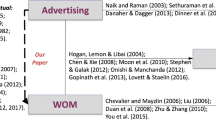Abstract
This article examines the dynamic impact of online word-of-mouth (WOM) on US television show viewership. With WOM data collected from the Internet Movie Database website, we find that the cumulative volume of online WOM has significant explanatory power for viewership over time. Consistent with the mere exposure effect theory, the dynamic impact of the volume of online WOM over time varies according to a curvilinear, inverted U-shaped curve. Due to an initial floor effect, the volume of WOM is not significant in the early episodes. The impact of volume increases over time, before peaking and starting to decrease in the latter part of a show’s life. This article demonstrates the differential effects of online WOM over time and thereby suggests that firms’ online marketing strategies, such as media planning, must adjust with the product life cycle.

Similar content being viewed by others
Notes
Although consumers are more likely to access recent information, the importance of past information likely decreases; so, our model grants greater weight to recent than to older online WOM information.
Our data collection thus might suffer from a selection bias, because we focused on successful products (De Bruyn and Lilien 2008). However, our data set includes a wide range of heterogeneous shows; including unsuccessful shows canceled after as few as 26 episodes. This heterogeneity in product popularity is consistent with the research recommendations formulated by Zhu and Zhang (2010).
The data include five Super Bowl events. For example, the episode of Grey’s Anatomy broadcast on February 5, 2006, was watched by more than 37 million viewers, whereas the show’s average viewership for the season was less than 20 million, representing a 185 % increase.
With few time periods and many panel participants, estimation of a fixed effect model with lagged dependent variables may be subject to finite-sample bias (Arellano and Bond 1991). However, the bias is unlikely to be substantial in our sample, because the number of observations per show is not low (M = 89) and the number of shows is not large (N = 41). We also ran regressions for a random effect model, but the Hausman test revealed that the group-specific term is correlated with the independent variables, which violates the hypothesis of a random effect model and could lead to biased estimates.
We also ran a regression with daily online WOM instead of cumulative information. Consistent with Godes and Mayzlin (2004), both daily volume and valence were not significant in this alternative model.
We start with τ = 5, or the shortest period that includes enough data to estimate the model.
References
Ajzen, I., & Fishbein, M. (1980). Understanding attitudes and predicting social behavior. Englewood Cliffs: Prentice Hall.
Anderson, E. (1998). Customer satisfaction and word of mouth. Journal of Service Research, 1(1), 5–17.
Arellano, M., & Bond, S. (1991). Some tests of specification for panel data: Monte Carlo evidence and an application to employment equations. Review of Economic Studies, 58(2), 277–297.
Chevalier, J. A., & Mayzlin, D. (2006). The effect of work of mouth on sales: online book reviews. Journal of Marketing Research, 43(4), 345–354.
Clemons, E. K., Gao, G., & Hitt, L. M. (2006). When online reviews meet hyperdifferentiation: a study of the craft beer industry. Journal of Management Information Systems, 23(2), 149–171.
De Bruyn, A., & Lilien, G. L. (2008). A multi-stage model of word-of-mouth influence through viral marketing. International Journal of Research in Marketing, 25(3), 151–163.
Dellarocas, C., Zhang, M., & Awad, N. F. (2007). Exploring the value of online product reviews in forecasting sales: the case of motion pictures. Journal of Interactive Marketing, 21(4), 23–45.
Duan, W., Gu, B., & Whinston, A. B. (2008). Do online reviews matter? An empirical investigation of panel data. Decision Support Systems, 45(4), 1007–1016.
Godes, D., & Mayzlin, D. (2004). Using online conversations to study word-of-mouth communication. Marketing Science, 23(4), 545–560.
Godes, D., & Silva, J. C. (2011). Sequential and temporal dynamics of online opinion. Marketing Science, 31(3), 448–473.
Godes, D., Mayzlin, D., Chen, Y., Das, S., Dellarocas, C., Pfeiffer, B., et al. (2005). The firm’s management of social interactions. Marketing Letters, 16(3/4), 415–428.
Idato, M. (2011, June 16). Word’s out, geeks rule. The Sydney Morning Herald. Retrieved November 19, 2013, from http://www.smh.com.au/entertainment/tv-and-radio/words-out-geeks-rule-20110615-1g2c7.html.
Janiszewski, C. (1993). Preattentive mere exposure effects. Journal of Consumer Research, 20(3), 376–392.
Liu, Y. (2006). Word of mouth for movies: its dynamics and impact on box office revenue. Journal of Marketing, 70(4), 74–89.
McAlister, L., Sonnier, G., & Shively, T. (2012). The relationship between online chatter and firm value. Marketing Letters, 23(1), 1–12.
Moe, W., & Trusov, M. (2011). The value of social dynamics in online product ratings forums. Journal of Marketing Research, 48(3), 444–456.
Rogers, E. (1962). Diffusion of innovations. New York: The Free Press.
Van den Bulte, C., & Lilien, G. L. (2003). Two-stage partial observability models for innovation adoption. Working paper, Wharton School, University of Pennsylvania
Zajonc, R. B. (1968). Attitudinal effects of mere exposure. Journal of Personality and Social Psychology, 9(2), 1–27.
Zajonc, R. B., Shaver, P., Tavris, C., & Van Kreveld, D. (1972). Exposure, satiation, and stimulus discriminability. Journal of Personality and Social Psychology, 21(3), 270–280.
Zhu, F., & Zhang, X. (2010). Impact of online consumer reviews on sales: the moderating role of product and consumer characteristics. Journal of Marketing, 74(2), 133–148.
Acknowledgments
The author wishes to acknowledge the support of the AFNOR Chaire Performance des Organisations of the Foundation of Paris-Dauphine. The author would also like to thank Beatrice Parguel, Manuel Cartier and the participants in the Paris Dauphine ERMES seminar, the 2013 BPF Camp in HEC Paris, and the 2013 Marketing Science Conference.
Author information
Authors and Affiliations
Corresponding author
Rights and permissions
About this article
Cite this article
Cadario, R. The impact of online word-of-mouth on television show viewership: An inverted U-shaped temporal dynamic. Mark Lett 26, 411–422 (2015). https://doi.org/10.1007/s11002-013-9278-6
Published:
Issue Date:
DOI: https://doi.org/10.1007/s11002-013-9278-6




